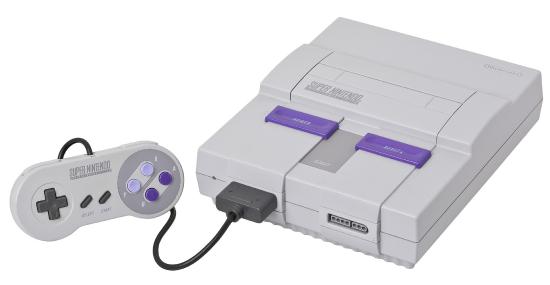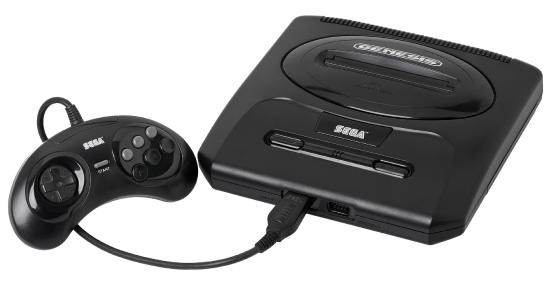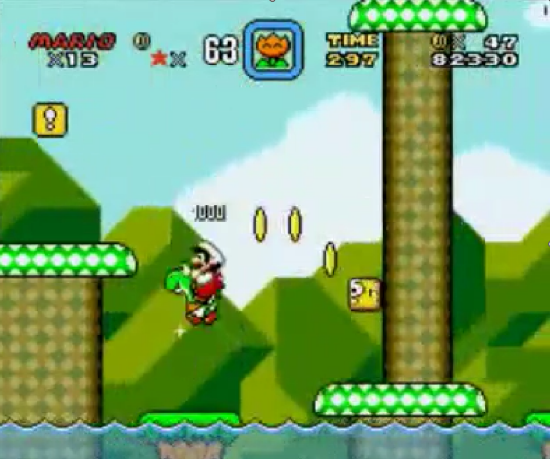14.3: Now, with real instruments! 16-bit video games and beyond
- Page ID
- 172128
Music in 16-bit video games: the Super Nintendo and sound sampling.


(left): Super Nintendo, by Evan-Amos, Public Domain; (right): Sega Genesis, by Evan-Amos, CC BY-SA 3.0.
The "fourth generation" of video games began in 1987 with the TurboGraphix-16, though the most popular systems were again created by Nintendo and Sega. 16-bit games ushered in a new era: higher quality graphics that provided for a quasi 3-dimensional visual aesthetic, and higher quality sound allowed for composers to write music that sounded like—or at least resembled—real instruments. Systems like the Super Nintendo, Sega Genesis, and the Neo-Geo provided more realistic gameplay and music to accompany the games. Musically, each system had their own unique soundchips that allowed for instrument sampling (similar to the 5th channel in the NES sound chip). Composers now had an "electronic orchestra" at their fingertips: they could use orchestral instruments, rock band sounds, and everything in between, to create a more colorful musical soundtrack. This short video provides a more elaborate discussion on the intricacies of the soundchips in the Super Nintendo: you'll learn how composers were able to create a vast soundscape for each of their games. With the new technology capacity for longer, and more colorful music, composers began to employ compositional techniques found in traditional repertoire (this is not to say that traditional techniques were not found in earlier games, but they were arguably fully exploited in these games).
Thematic Development in Koji Kondo's Super Mario World.

Screenshot of Nintendo's 1990 release of Super Mario World for the Super Nintendo (Screenshot taken from YouTube).
The 16-bit game Super Mario World was truly a landmark in both gameplay and compositional style within video games. The game's graphics allowed for a "3D/2D" aesthetic: 2-dimensional characters moving in what appears to be a 3-dimensional environment. Composer Koji Kondo (who had composed the music for all of the Mario games to this point) created a soundtrack that was based off of a single recurring theme that endures different transformational procedures, which all depended on the different level's environment. Take a listen to this opening track, known as the "Overworld" music. This theme is the recurring theme (sometimes called a cyclic theme, because the theme comes back "round and round" like a cycle). Watch this gameplay with the "Overworld" music in the background. See if you can make out the instruments being used. You should be able to hear what sounds like ukelele, tuba or bass, and a steel drum—which never would have been possible in the 8-bit era!
As mentioned above, this cyclic theme accompanies every single level, but depending on its environment, the music is played differently. For instance, when Mario is underwater, we hear the melody played like a waltz, using lots of glockenspiel and bass; when Mario goes underground, we hear the melody played by an upright bass with lots of marimba and other percussion. When Mario's stage has no ground, we hear the melody in the style of ragtime (as an homage to famous ragtime composer Scott Joplin); when Mario enters a Haunted House, we hear the melody played in the minor mode with lots of dissonance and eerie sound effects accompanying the melody, and when he enters Bowser's Castles, we hear the melody again played in the minor mode with more strange sound effects.
This technique is known as thematic transformation: while the melody remains largely unchanged, the surrounding musical elements are varied throughout the game. Instruments change, the register of the melody is changed, the key (major or minor) may change, the tempo (speed) or meter (time signature) can also change—everything that affects the theme can change, but the theme itself remains the same! This allows composers to unify the soundtrack while also affecting the players' immersion. Players may see the musical theme as a musical representation—a leitmotif—of the character, and by extension, of themselves as well! By changing the theme's musical surroundings, players may fully immerse themselves into the game through the music! A handout on this game is attached to this page; view this as you watch the video presentation for this unit. It covers in more detail Koji Kondo's compositional techniques in Super Mario World.
When you're done listening to these different transformations of Mario's theme, watch the video presentation for this unit; it covers the different transformations in further detail. Then, move to the next page that discusses cinematic storytelling in video games.

